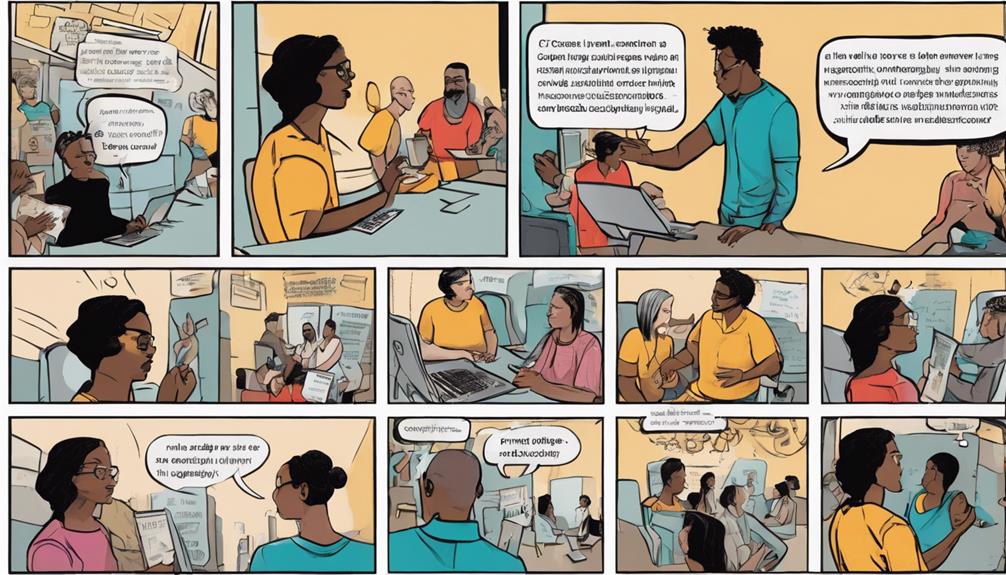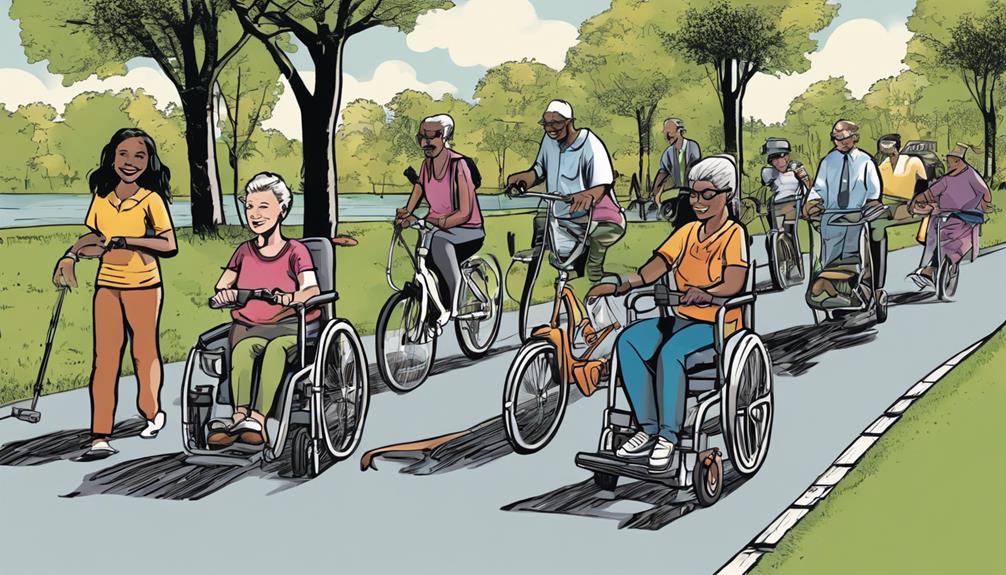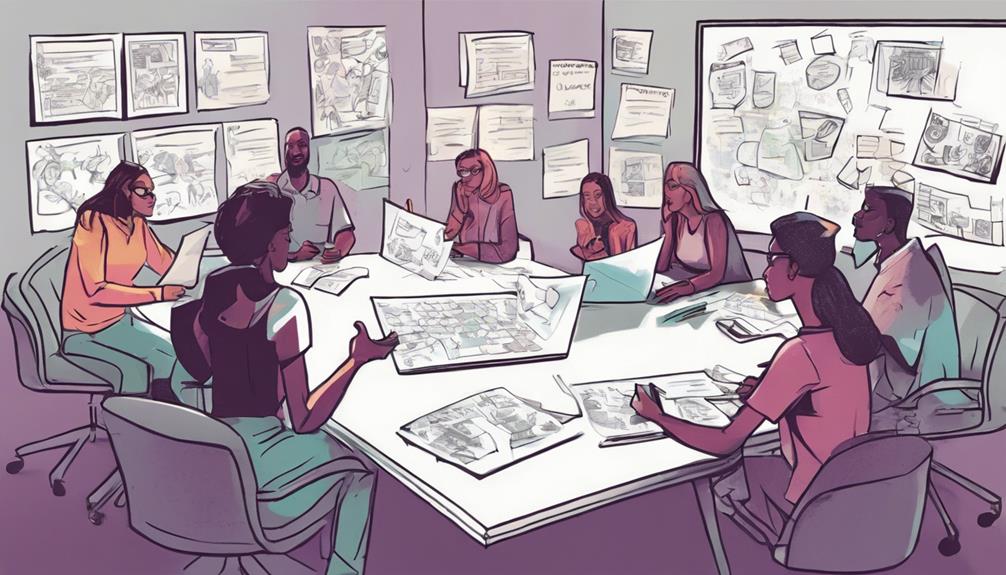When a workplace offers flexible work hours to support employees with diverse caregiving duties, it showcases equitable thinking and design. This scenario guarantees that all employees have equal opportunities to balance their work and personal responsibilities. By implementing flexible work hours, the workplace promotes inclusivity and addresses individual needs effectively. If you're intrigued by this example, there are more instances of equitable thinking and design discussed in the research that can broaden your understanding.
Key Takeaways
- Prioritizing inclusivity in designing educational resources for students with diverse learning needs.
- Ensuring equal access to facilities and support systems for all learners.
- Celebrating diversity through design choices that benefit all individuals equally.
- Addressing disparities in design to promote fairness and inclusivity.
- Creating a supportive environment in education that caters to individual student needs.
Equitable Thinking Definition
Fair thinking entails considering fairness, justice, and inclusivity in decision-making processes. It involves ensuring equal opportunities by addressing disparities and promoting diversity. Design choices are made to benefit everyone equally, irrespective of individual differences.
By prioritizing fair design, communities can offer genuinely equal social experiences to all members. Fair thinking aims to eliminate barriers and ensure equal access to resources for every individual. It creates a level playing field where everyone has a fair chance to succeed.
This mindset is crucial in fostering a more inclusive and just society, where decisions prioritize equality and justice for all. Integrating fair thinking into various aspects of life, from policy-making to everyday interactions, can contribute to a more fair and harmonious world.
Importance of Equitable Design

Equitable design plays an important role in fostering fairness, justice, and inclusivity in decision-making processes. It guarantees that products, services, or systems are created to benefit all individuals equally, promoting accessibility and equal opportunities.
By prioritizing inclusivity, equitable design aims to address disparities and provide a level playing field for everyone involved. For instance, in education, equitable design could involve developing educational resources that are accessible to all students, regardless of their backgrounds or abilities. This approach not only enhances the learning experience for all students but also contributes to a more equitable and just educational system.
Companies like Brainly can further encourage equitable thinking by promoting diversity and inclusivity within their online communities, creating spaces where everyone feels valued and respected. Embracing equitable design principles leads to more balanced and inclusive outcomes, ultimately fostering a more equitable society for all.
Equitable Design in Education

In the field of education, designing learning environments that cater to the diverse needs of all students is essential. Equitable design in education focuses on creating a fair and inclusive educational experience where every student has equal opportunities for learning and academic success. This approach guarantees that educational resources, facilities, and support systems are accessible to all learners, regardless of their socio-economic background, disabilities, or learning styles.
By considering these factors, equitable design promotes inclusivity in education and aims to eliminate barriers that may impede students' learning experiences. The goal is to provide a supportive environment that caters to the individual needs of each student, fostering a sense of belonging and equity within the educational setting.
Through equitable design, educators can work towards creating a learning environment where all students have the opportunity to thrive and succeed academically.
Promoting Inclusivity in Design

You can start by exploring the principles of equitable design, understanding its benefits, and how it promotes equal opportunities for all individuals.
By embracing inclusivity in design, you create spaces and products that cater to diverse needs and backgrounds, fostering a sense of belonging and accessibility for everyone involved.
This approach not only eliminates barriers but also encourages innovation and creativity through a more inclusive and equitable design process.
Equitable Design Principles
Promoting inclusivity in design involves prioritizing diversity and considering a wide range of needs and experiences. Equitable design principles play an essential role in securing fairness and equal access for all individuals within a designed space. By implementing inclusive design practices, designers can create environments that cater to the diverse needs of various user groups, fostering a sense of belonging and community cohesion.
Equitable Design Principles: By following equitable design principles, designers can secure that everyone has access to the same opportunities in design choices.
Inclusive Design: Creating spaces that are inclusive and welcoming to all individuals is a foundation of equitable design.
Diverse Needs: Equitable design considers a broad range of diverse needs and experiences to promote fairness and inclusivity.
Equal Access: Prioritizing equity in design aims to eliminate barriers and secure equal access for all users within a designed space.
Benefits of Inclusivity
Enhancing inclusivity in design promotes equal access and user satisfaction across diverse backgrounds and needs. Inclusive design not only ensures accessibility but also considers a wide array of user experiences, leading to more thorough design solutions.
By embracing inclusivity, products and services can cater to various genders, locations, languages, and abilities, promoting a sense of belonging for all users. This approach goes beyond mere compliance with regulations; it aims to create a positive user experience for everyone involved.
Inclusive design strengthens brand identity and reputation by showing a commitment to serving a broad range of users. Ultimately, prioritizing inclusivity in design leads to more effective, user-friendly solutions that resonate with a larger audience.
Embracing inclusivity can enhance the impact of design solutions and contribute to a more equitable and inclusive society as a whole.
Promoting Equal Opportunities
By prioritizing inclusivity in design, you guarantee equal chances for all individuals, fostering a more accessible and user-friendly experience. Equitable thinking involves considering fairness, justice, and inclusivity in decision-making to promote equal chances.
Designing equitably entails creating products, services, or systems that benefit all individuals equally regardless of differences. An example of equitable design could be developing educational resources accessible to all students, ensuring inclusivity. Equitable thinking aims to address differences and secure equal chances for everyone in the design process.
- Fairness: Ensuring that all individuals have equal opportunities and treatment in accessing products, services, or systems.
- Inclusivity: Designing with the intention of accommodating individuals with diverse abilities and backgrounds.
- Disparities: Identifying and addressing existing gaps or discrepancies to promote equality in opportunities.
- Equal Opportunities: Providing a level playing field for all individuals, regardless of differences, to access and benefit from designed solutions.
Addressing Disparities in Design

You should consider how fairness plays an essential role in design, ensuring that all individuals are equally valued and included.
Making inclusive decisions and designing solutions that benefit everyone regardless of differences are key aspects of addressing disparities in design.
Fairness in Design
Consider ways to address disparities in design by prioritizing fairness and inclusivity in your approach. Fairness in design is essential to guaranteeing equal opportunities for all individuals.
By incorporating justice and inclusivity into your design process, you can create products, services, or systems that benefit everyone equally.
Here are some key strategies to promote fairness in design:
- Identify Disparities: Recognize existing gaps or inequalities in your design process that may impede fairness.
- Engage Diverse Perspectives: Seek input from a wide range of individuals to promote inclusivity and address different needs.
- Provide Accessible Solutions: Make sure your designs are accessible to all users, regardless of their background or abilities.
- Promote Equity: Work towards creating a level playing field for all individuals by considering fairness and justice in every design decision you make.
Inclusive Decision-making
Addressing disparities in design involves prioritizing inclusive decision-making to ensure fairness and equity in the design process. Inclusive decision-making guarantees that diverse needs are considered and that solutions are designed to cater to a wide range of experiences. By actively involving individuals from various backgrounds in the decision-making process, designers can create more inclusive solutions that address disparities and promote fairness.
To illustrate the importance of inclusive decision-making in design, consider the following comparison table:
| Traditional Decision-making | Inclusive Decision-making |
|---|---|
| Limited perspectives considered | Diverse perspectives included |
| Decisions based on assumptions | Decisions based on insights |
| Excludes marginalized voices | Amplifies marginalized voices |
| Results in less equitable outcomes | Results in fair and inclusive solutions |
Equitable Design Solutions
Equitable design solutions aim to bridge disparities in design by fostering fairness and inclusivity in the creation of user-centered spaces. By considering factors like accessibility, diversity, and inclusivity, equitable design guarantees that spaces cater to a wide range of needs and preferences.
This approach goes beyond mere equality, working to provide equal opportunities and experiences for all individuals, regardless of their unique differences. Prioritizing equitable thinking in design not only eliminates barriers but also fosters a sense of equality and belonging within communities.
Through the implementation of equitable design practices, spaces become more inclusive and accessible, benefiting a diverse range of users.
Accessibility: Ensuring that spaces are designed to be usable by individuals of all abilities.
Inclusivity: Creating environments that welcome and cater to people from various backgrounds and identities.
Diversity: Incorporating a range of perspectives and needs to promote a more representative and inclusive design.
Equal Opportunities: Providing fair and unbiased access to resources and experiences within designed spaces.
Benefits of Equitable Thinking

Promoting fairness, justice, and inclusivity, equitable thinking offers numerous benefits in decision-making processes. By incorporating equitable thinking into your strategies, you make sure that individual differences are considered, fostering a sense of belonging and inclusivity among all stakeholders. Additionally, designing equitably leads to the creation of products, services, or systems that benefit all individuals equally. Equitable thinking encourages the development of accessible and inclusive spaces for a diverse range of users.
To further illustrate the benefits of equitable thinking, consider the following table:
| Benefits of Equitable Thinking |
|---|
| Promotes fairness and justice |
| Fosters inclusivity and belonging |
| Considers individual differences |
| Creates accessible spaces for diverse users |
Ensuring Equal Opportunities

You need to guarantee that your design decisions are fair and inclusive, providing equal opportunities for everyone involved.
By thinking about fairness in your design process, you can create solutions that benefit all individuals equally.
This approach promotes diversity and helps eliminate disparities, fostering a more inclusive environment.
Fairness in Design
Ensuring equal opportunities in design involves creating products, services, or systems that provide fair access to all individuals, regardless of differences. When focusing on fairness in design, it's vital to address:
- Equitable Thinking: Incorporating principles of fairness, justice, and inclusivity in the design process.
- Accessibility: Ensuring that products and services are easily accessible to all individuals, regardless of any disabilities or limitations they may have.
- Inclusivity: Designing with the goal of benefiting all individuals equally, without excluding any particular group or community.
- Fairness: Promoting equality by addressing disparities and providing equal opportunities for everyone in the design of products, services, or systems.
Inclusive Decision-Making
One key aspect of ensuring equal opportunities in design is fostering inclusive decision-making processes that consider the needs and perspectives of all individuals involved.
Equitable thinking involves promoting fairness, justice, and inclusivity in decision-making to create a level playing field for everyone. By incorporating inclusive decision-making practices, designers can address disparities and guarantee that all voices are heard, leading to more just and equitable outcomes.
Inclusive decision-making is vital in designing equitably, as it enables the development of products, services, or systems that benefit all individuals equally, regardless of differences. For instance, creating educational resources accessible to all students exemplifies equitable design by guaranteeing equal access to learning materials.
Platforms like Brainly can play a role in encouraging equitable thinking by fostering diversity and inclusivity within their communities, allowing all users to have equal opportunities to learn and collaborate effectively.
Embracing inclusive decision-making practices is necessary in promoting fairness and inclusivity in design, ultimately leading to a more equitable and just society.
Strategies for Equitable Design

Implementing inclusive user research methods is crucial when developing strategies for equitable design. To secure that your design decisions prioritize equity, consider the following strategies:
- Prioritize Diversity: Guarantee that your design team and research participants represent a diverse range of backgrounds, experiences, and perspectives.
- Enhance Accessibility: Make certain that your designs are accessible to individuals of all abilities by considering factors such as physical, cognitive, and sensory needs.
- Promote Inclusivity: Create designs that cater to the needs of all users, regardless of their age, gender, race, or socio-economic status.
- Address Disparities: Identify and address any existing disparities within your design process to secure that your final product provides equal opportunities for all individuals.
Equitable Community Building

Equitable community building fosters an environment of fairness and inclusivity for all individuals involved. In creating inclusive spaces, it is vital to take into account the diverse needs of community members to guarantee fair opportunities for everyone. Equitable design plays an essential role in promoting justice and inclusivity in community development efforts. By prioritizing equity in community building, disparities and barriers can be effectively addressed, leading to a more cohesive and harmonious community.
| Equitable Design | Inclusive Spaces |
|---|---|
| Diverse Needs | Fair Opportunities |
| Community Development |
Taking into account diverse needs and perspectives in community development is a cornerstone of equitable design, guaranteeing that all individuals have fair opportunities to thrive within the community. By fostering inclusive spaces and promoting equitable thinking, communities can work towards creating a more just and inclusive environment for all.
Implementing Inclusive Practices

To promote inclusivity and fairness in your practices, consider incorporating inclusive design principles that benefit all individuals equally. When implementing inclusive practices, it's important to adopt a user-centered design approach that prioritizes the diverse needs of all users, including users with disabilities.
By integrating equitable design into your design process, you make sure that everyone, regardless of ability or background, can access and engage with your products or services. Inclusive practices not only enhance usability but also promote a more fair and welcoming environment for all individuals.
Through equitable design, you can create a positive impact by celebrating diversity and fostering equal social interactions within your community.
- Prioritize a user-centered design approach
- Consider the needs of users with disabilities
- Integrate equitable design into your design process
- Create a more inclusive and welcoming environment
Frequently Asked Questions
What Is an Example of Equitable Design?
When contemplating equitable design, it's crucial to prioritize equal treatment for all. Ensuring that everyone has similar experiences in urban spaces is a prime example of equitable design, celebrating diversity and inclusivity.
What Makes a Product Equitable in UX Design?
You make a product equitable in UX design by prioritizing fairness, inclusivity, and justice. Consider diverse user needs, celebrate differences, and create inclusive experiences. Designing with equity enhances user satisfaction, fosters inclusivity, and promotes sustainability.
What Is an Example of UX Design?
When considering UX design, focus on creating user-friendly interfaces that cater to diverse needs. Prioritize accessibility, inclusivity, and ease of use. Guarantee all users, regardless of background or abilities, can navigate and benefit from the product.
When Designing Across Platforms, the Platform That Best Meets Your User's Needs Should Be ____.?
When designing across platforms, the platform that best meets your user's needs should be prioritized. Consider accessibility features, usability, and inclusivity to guarantee equal opportunities for all users. Design with diverse user preferences in mind.
Conclusion
You've learned about the importance of equitable design in various contexts, from education to community building. By promoting inclusivity, addressing disparities, and ensuring equal opportunities, equitable thinking can create a more just and fair society.
Implementing inclusive practices may seem like a challenging task, but with dedication and creativity, you can make a world of difference. Remember, the impact of equitable design is as vast as the ocean and as powerful as a thousand suns.









